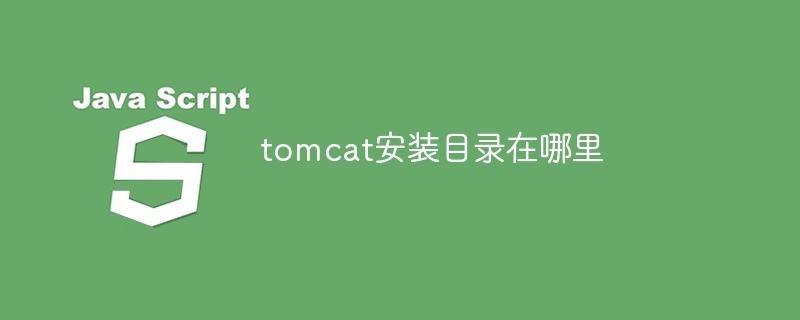Where is the tomcat installation directory?
Tomcat installation directory: Default path: Windows: C:\Program Files\Apache Software Foundation\Tomcat 9.0macOS:/Library/Tomcat/Tomcat 9.0Linux:/opt/tomcat/tomcat9 Custom path: during installation Can be specified. Find the installation directory: use whereis or locate command.

Tomcat installation directory
The Tomcat installation directory varies depending on the operating system.
Windows
- Default installation path:
C:\Program Files\Apache Software Foundation\Tomcat 9.0
macOS
- Default installation path:
/Library/Tomcat/Tomcat 9.0
Linux
- Default installation path:
/opt/tomcat/tomcat9
Customized installation path
During the installation process, you can choose to customize the installation path of Tomcat. Note that you must have write access to the selected path.
Steps to find the installation directory
If you are not sure where Tomcat is installed, you can use the following steps to find its installation directory:
- Open a command line window or terminal.
- Run the following command:
<code>whereis tomcat</code>
or
<code>locate tomcat</code>
- The command output will display a list of Tomcat installation directories.
The above is the detailed content of Where is the tomcat installation directory?. For more information, please follow other related articles on the PHP Chinese website!

Hot AI Tools

Undresser.AI Undress
AI-powered app for creating realistic nude photos

AI Clothes Remover
Online AI tool for removing clothes from photos.

Undress AI Tool
Undress images for free

Clothoff.io
AI clothes remover

Video Face Swap
Swap faces in any video effortlessly with our completely free AI face swap tool!

Hot Article

Hot Tools

Notepad++7.3.1
Easy-to-use and free code editor

SublimeText3 Chinese version
Chinese version, very easy to use

Zend Studio 13.0.1
Powerful PHP integrated development environment

Dreamweaver CS6
Visual web development tools

SublimeText3 Mac version
God-level code editing software (SublimeText3)

Hot Topics
 1664
1664
 14
14
 1421
1421
 52
52
 1315
1315
 25
25
 1266
1266
 29
29
 1239
1239
 24
24
 Linux Architecture: Unveiling the 5 Basic Components
Apr 20, 2025 am 12:04 AM
Linux Architecture: Unveiling the 5 Basic Components
Apr 20, 2025 am 12:04 AM
The five basic components of the Linux system are: 1. Kernel, 2. System library, 3. System utilities, 4. Graphical user interface, 5. Applications. The kernel manages hardware resources, the system library provides precompiled functions, system utilities are used for system management, the GUI provides visual interaction, and applications use these components to implement functions.
 laravel installation code
Apr 18, 2025 pm 12:30 PM
laravel installation code
Apr 18, 2025 pm 12:30 PM
To install Laravel, follow these steps in sequence: Install Composer (for macOS/Linux and Windows) Install Laravel Installer Create a new project Start Service Access Application (URL: http://127.0.0.1:8000) Set up the database connection (if required)
 Docker on Linux: Containerization for Linux Systems
Apr 22, 2025 am 12:03 AM
Docker on Linux: Containerization for Linux Systems
Apr 22, 2025 am 12:03 AM
Docker is important on Linux because Linux is its native platform that provides rich tools and community support. 1. Install Docker: Use sudoapt-getupdate and sudoapt-getinstalldocker-cedocker-ce-clicotainerd.io. 2. Create and manage containers: Use dockerrun commands, such as dockerrun-d--namemynginx-p80:80nginx. 3. Write Dockerfile: Optimize the image size and use multi-stage construction. 4. Optimization and debugging: Use dockerlogs and dockerex
 Understanding macOS: A Beginner's Guide
Apr 22, 2025 am 12:11 AM
Understanding macOS: A Beginner's Guide
Apr 22, 2025 am 12:11 AM
The basic operations of macOS include starting applications, managing files, and using system settings. 1. Start the application: Use the Terminal command "open-aSafari" to start the Safari browser. 2. Manage files: browse and organize files through Finder. 3. Use system settings: understand the functions of Dock and Launchpad to improve operational efficiency. Through these basic operations, you can quickly master how to use macOS.
 macOS: Security, Privacy, and Reliability
Apr 24, 2025 am 12:08 AM
macOS: Security, Privacy, and Reliability
Apr 24, 2025 am 12:08 AM
macOS performs excellent in security, privacy protection and reliability: 1) Security is protected through sandbox technology, multi-layer defense strategy such as Gatekeeper and XProtect; 2) Privacy protection allows users to control applications' access to sensitive data through the TCC framework; 3) Reliability ensures the stable operation of the system through regular updates and TimeMachine backups.
 Tomcat starts Servlet error java.lang.IllegalStateException: How to troubleshoot servlet-api.jar loading problem?
Apr 19, 2025 pm 04:36 PM
Tomcat starts Servlet error java.lang.IllegalStateException: How to troubleshoot servlet-api.jar loading problem?
Apr 19, 2025 pm 04:36 PM
Tomcat starts Servlet error check When troubleshooting. When deploying Servlet application, Tomcat failed to start and reported java.lang.IllegalStateException:...
 macOS: System Architecture and Core Components
Apr 28, 2025 am 12:05 AM
macOS: System Architecture and Core Components
Apr 28, 2025 am 12:05 AM
The system architecture of macOS includes hardware abstraction layer, XNU core, I/OKit, core services and Aqua user interface. Core components include the startup process, the APFS file system, and SystemIntegrityProtection. Performance optimization and best practices involve hardware configuration, software setup, and development skills.
 How to understand DMA operations in C?
Apr 28, 2025 pm 10:09 PM
How to understand DMA operations in C?
Apr 28, 2025 pm 10:09 PM
DMA in C refers to DirectMemoryAccess, a direct memory access technology, allowing hardware devices to directly transmit data to memory without CPU intervention. 1) DMA operation is highly dependent on hardware devices and drivers, and the implementation method varies from system to system. 2) Direct access to memory may bring security risks, and the correctness and security of the code must be ensured. 3) DMA can improve performance, but improper use may lead to degradation of system performance. Through practice and learning, we can master the skills of using DMA and maximize its effectiveness in scenarios such as high-speed data transmission and real-time signal processing.




